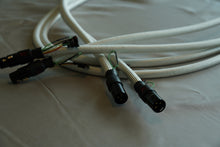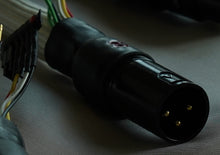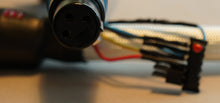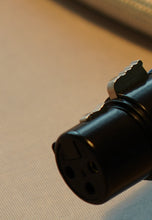XLR^2 Analogue Interlink (pair)
Regular price
€470.00
Sale
The XLR^2 all configurable cable is the latest in our ^2 portfolio (and Phasure never carried a normal XLR cable as we left that to the 4 or even 5 digits costing boutique manufacturers).
General description
With the by now 3 year experience from shield-configurable cables, we were confident to supply a most normal XLR interlink in the ^2 fashion, and on top of that used the very best materials. Very best ? what is that ? easy : oxygen-free, thickest gauge available in the market, the about lowest capacitance possible for this type of cable a highest propagation time and with this all : the highest possible bandwidth.
Necessary for audio ? we claim Yes, because it always goes like that; higher bandwidth always sounds better, no matter officially it is not necessary (this is a long story, so go ahead and ask on the Phasure forum, if you like).
The thick gauge per wire comes in star-quad configuration for this analogue interlink (also see the XLR^2-D digital (AES/EBU) version, which is very different), which mathematically doubles the (stranded) "copper" again.
The inner shielding per signal wire (4x) is of a very special type (double) counter-twisted type, which shields are not connected to anything - not even to each other.
By kind of "solve all issues challenge" the XLR^2(-D) could be the first XLR cable which solves the ever so annoying issue of "do we connect the cable's ground to the connector (hence chassis) or do we leave it floating ?". Well, we just configure it ! See the green wire in the pictures; you can see it is a special connection unrelated to the shields and green connects to green or is left open. You can choose this per side (A or B) and thus fulfill each "advice" from any direction (leave open at the receiving end ! ... no no ... leave open at the transmitting end of course ! ... plus 2 more options - connect both - leave both open).
The Black wire as we know it from all the ^2 cables, in this case connects to the ground pin of the connector(s).
Do notice that the ground itself - unlike normal XLR cables - can be disconnected; in practice this means that we do not connect the black wire (which connects to the XLR ground pin) with any of the White (inner shield), Yellow (middle shield) or Red (outer shield). Also notice that ground as such is not necessary for differential (balanced) systems, but that some device to device connections like to have it anyway. All this can be chosen for best performance and most certainly the best sound possible.
Lastly notice that since this is an analogue cable (meant for analogue connections anyway) the impact of these configurations to the sound, is huge (unlike digital connections where it matters far less).
The connectors are of the most robust industrial type (not Neutrik) with gold plated pins and sockets.
The XLR^2 is not rated for impedance, as this is not in order for analogue connections of this particular kind. However, what *is* crucial is that the XLR^2 is the most stable regarding reactances over all the audio frequencies (say 20Hz - 20KHz).
(for a 110 Ohm impedance cable, please order the XLR^2-D).
Length
You can virtually choose any length you like (see the provided list) but it gets progressively more expensive. This is because of the way the sleeves (also the internal insulation layers) have to be assembled, which goes caterpillar like and requires progressively more and more "caterpillar moves" the longer the cable gets.
Would you like 8 meters or even more ? no worries because the XLR^2 will perform the same as if it were 1 meter. But better have some deeper pockets ...
Some further physical properties (coming soon !) :
Thickness : xxmm
Air dielectric approximately : xmm (at each side of the main conductor)
Number of screens : 3 (fully configurable for connections at each end)
Insulation layers : between each screen
Weight per 1m per cable : xxxgr
Capacitance : xxpF/m
Velocity of propagation (% of speed of light) : xx
Loss over 100m at 1MHz : xxdB
Minimum bending diameter from outside to outside : 14cm (radius 7cm)
Required extra length per 90 degree required bend : 7cm
Configuration possibilities : 255 (excluding chassis connections at each end)
We are maintaining the actual lead time to shipment for new cables : 2 business days.












